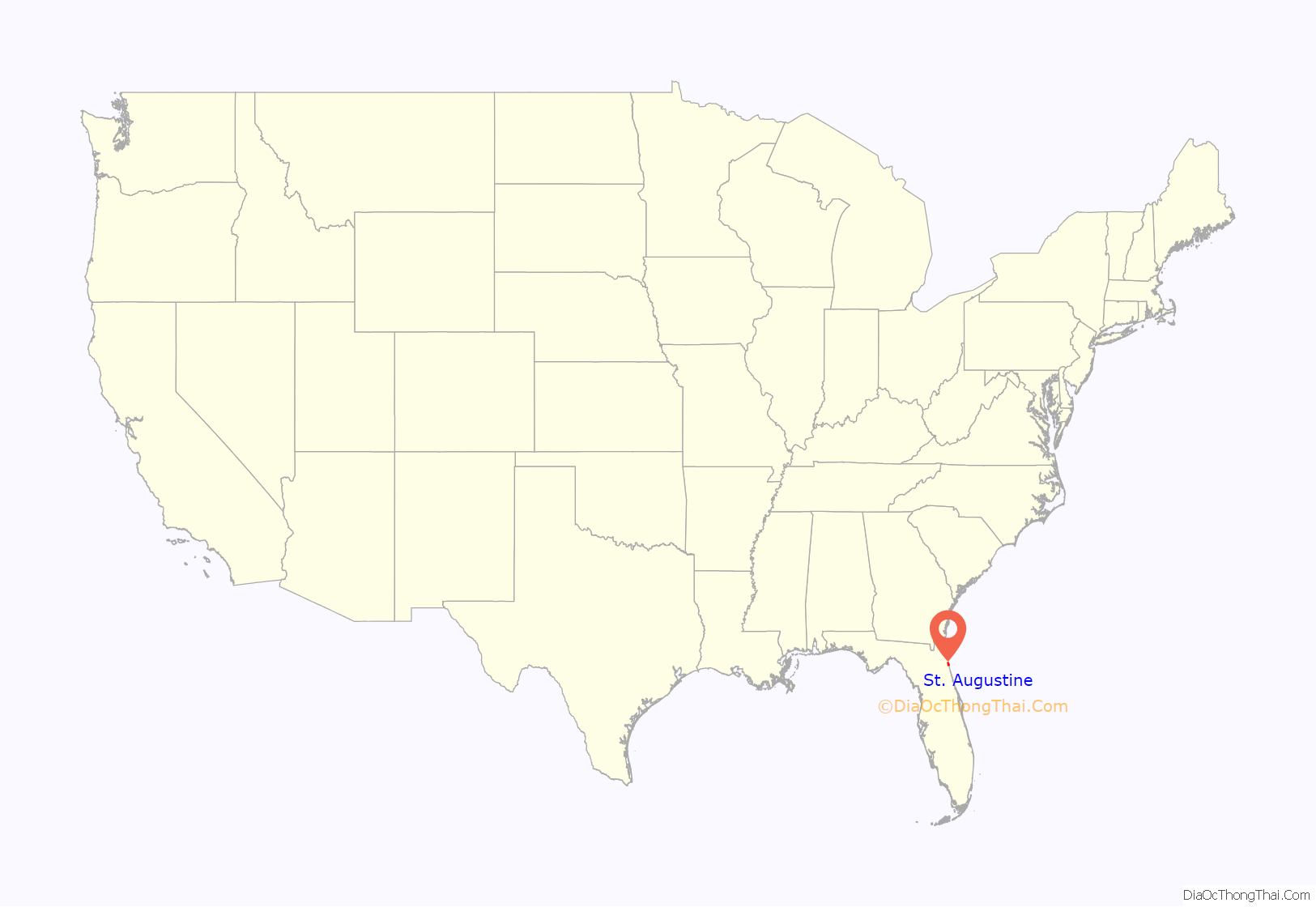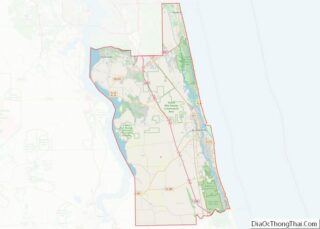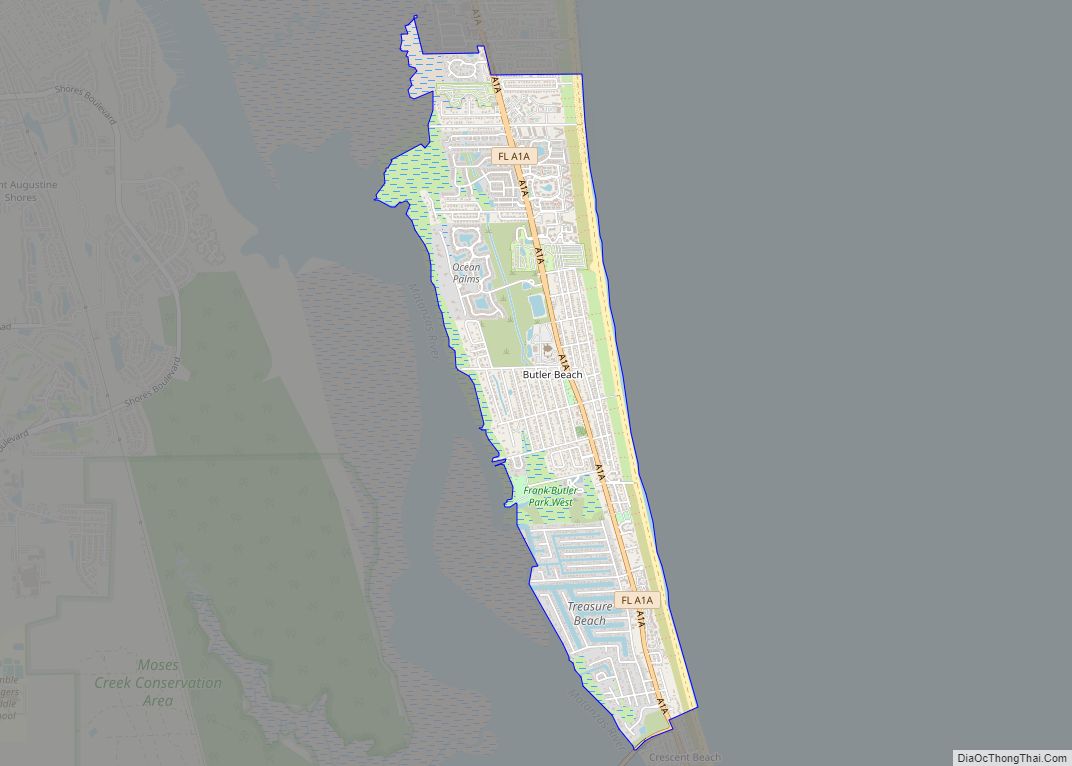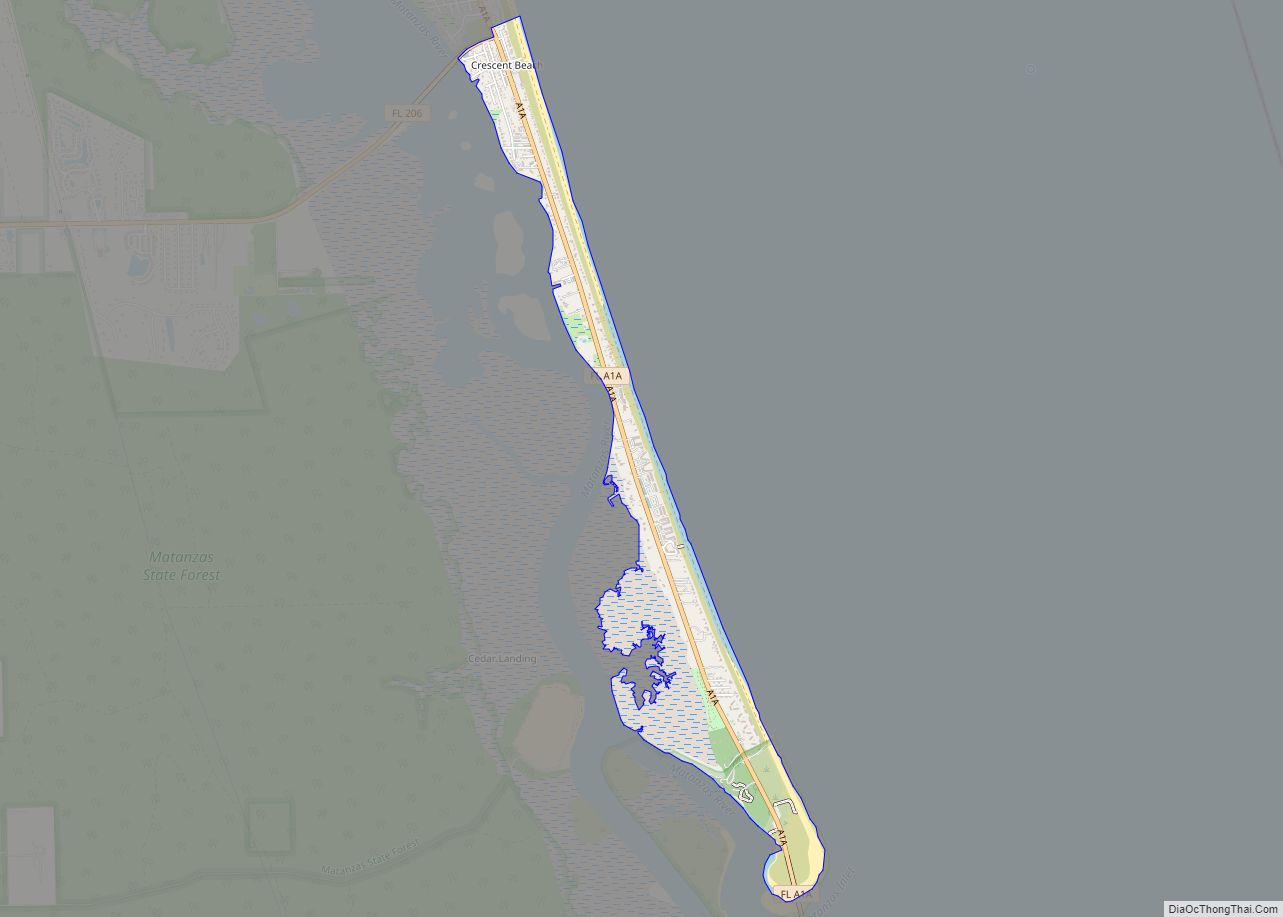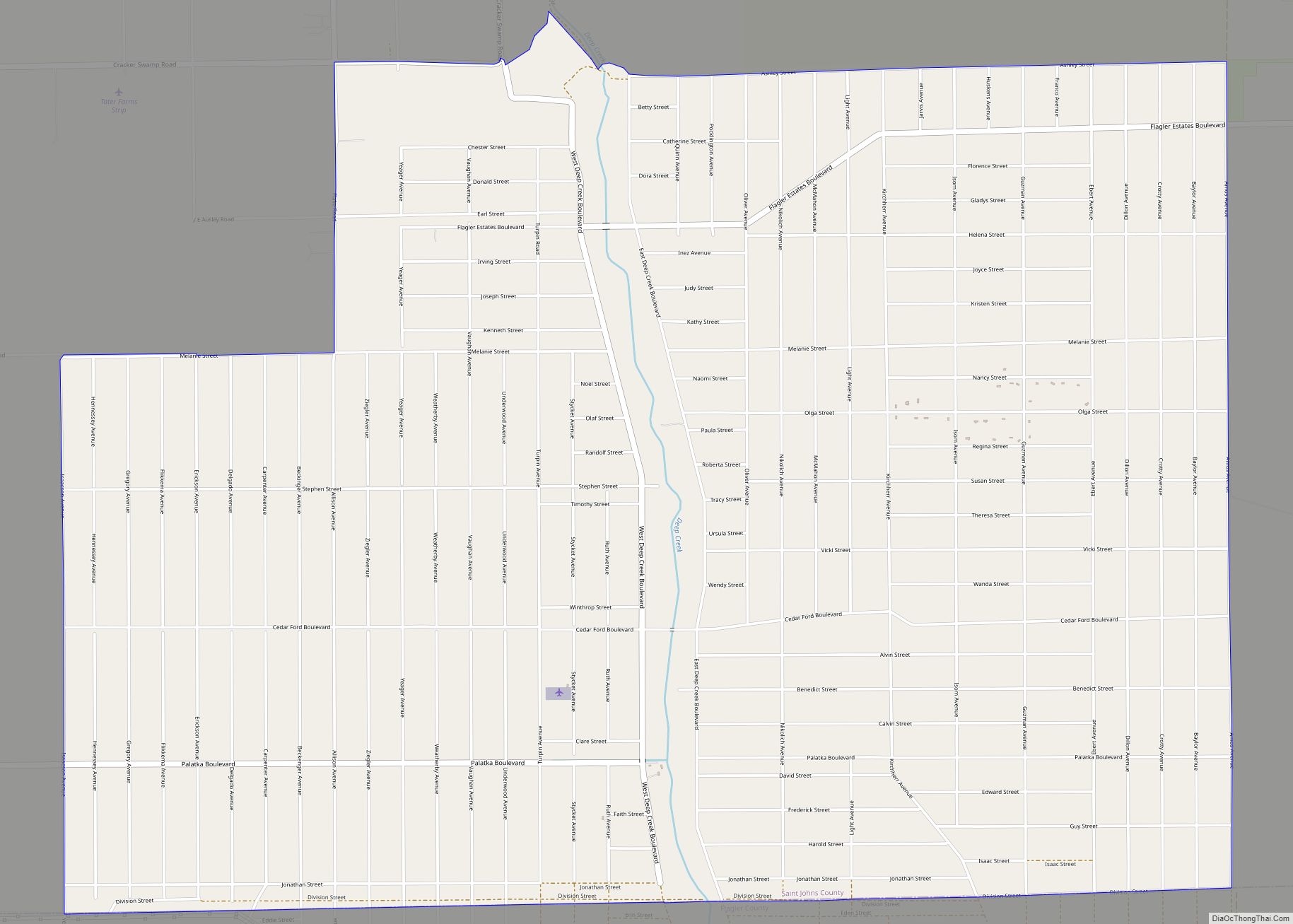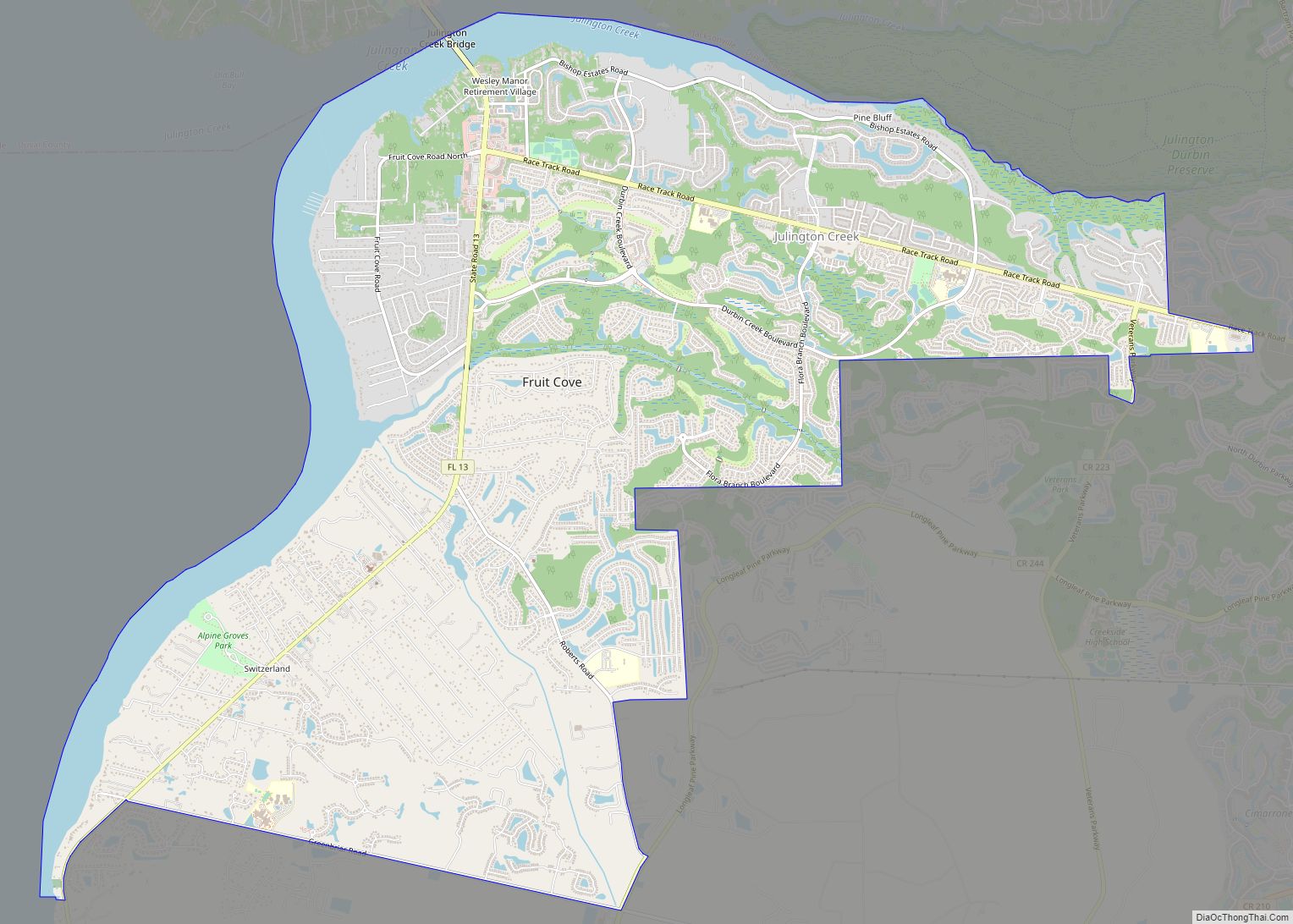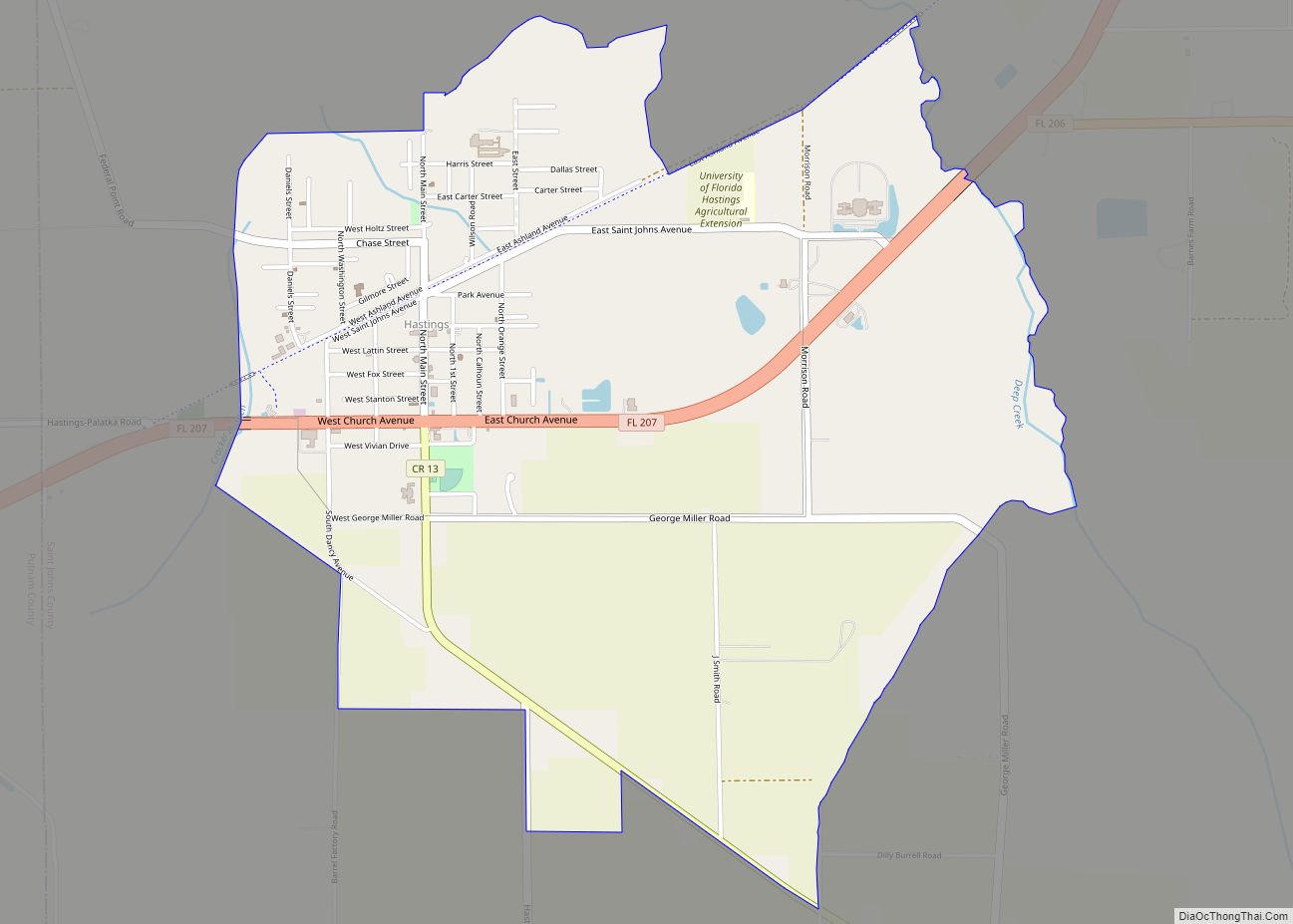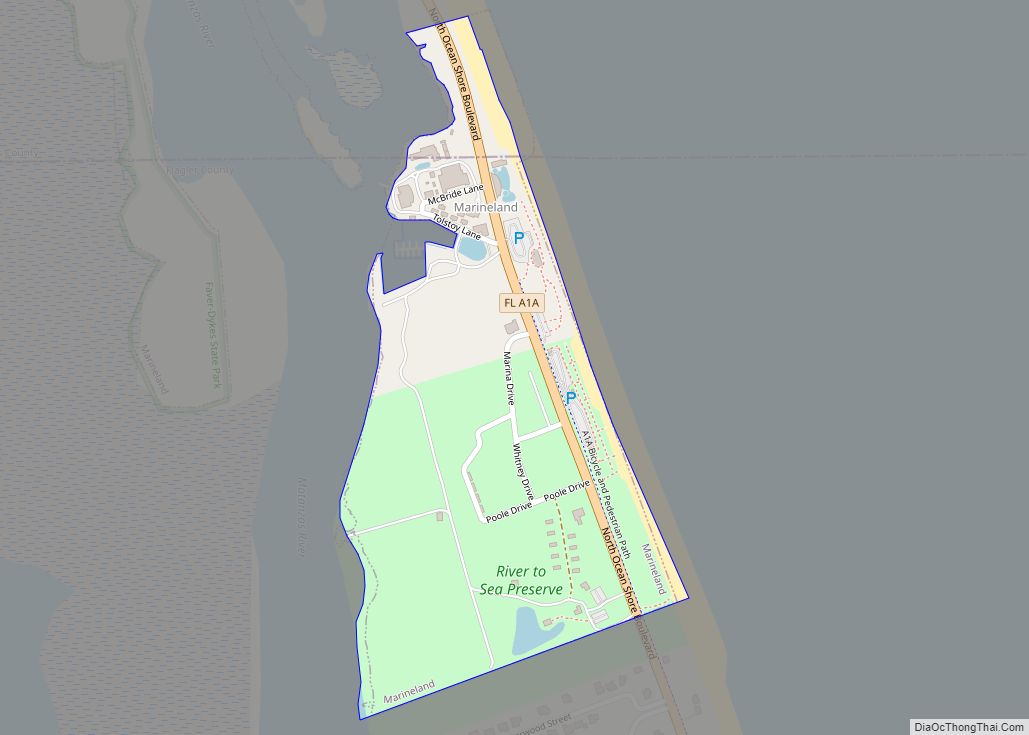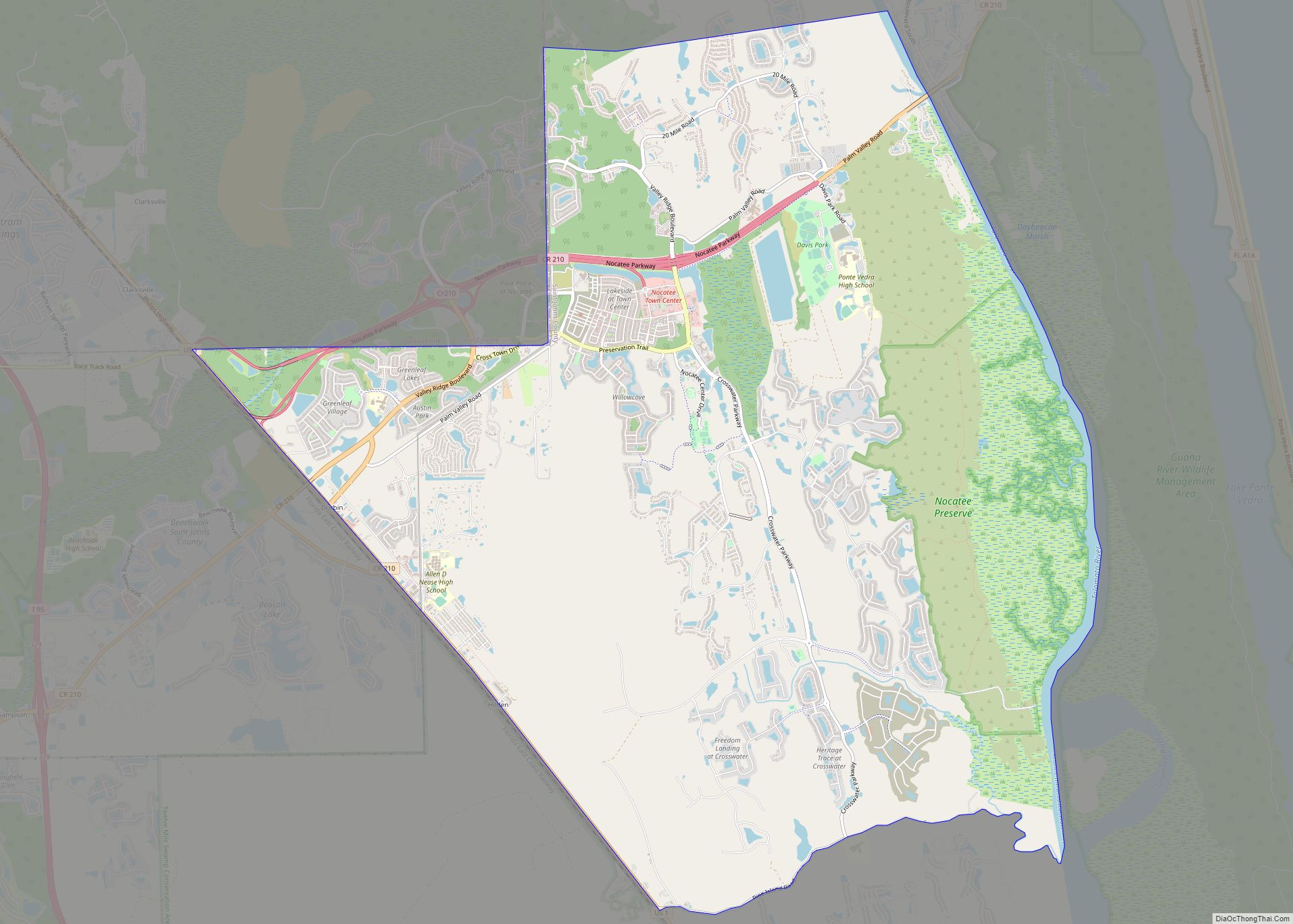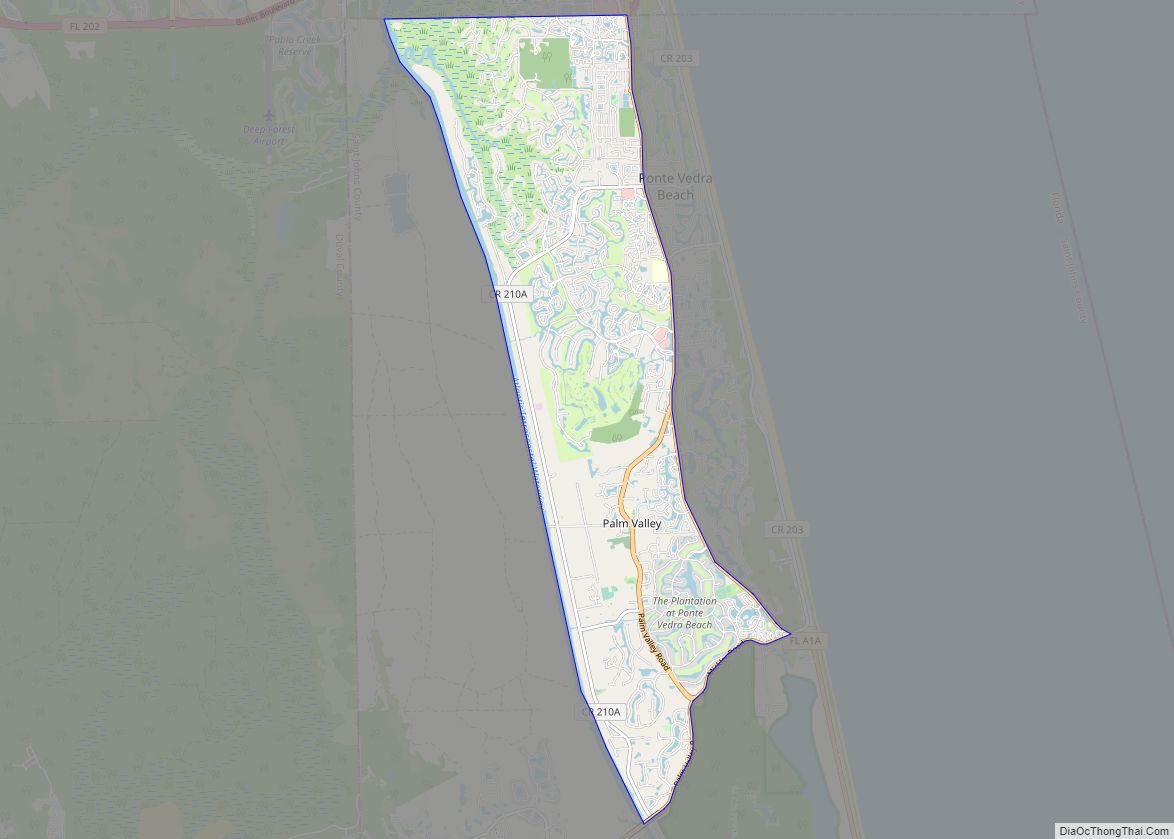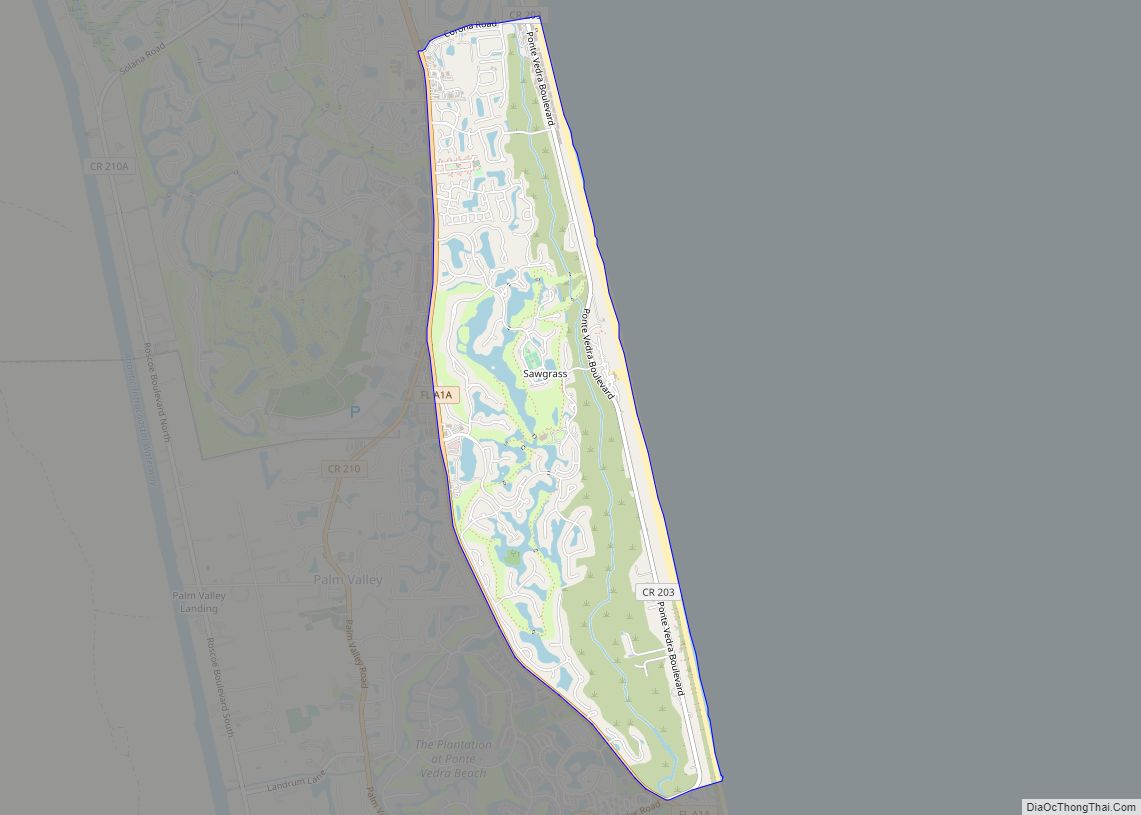| Name: | St. Augustine city |
|---|---|
| LSAD Code: | 25 |
| LSAD Description: | city (suffix) |
| State: | Florida |
| County: | St. Johns County |
| Elevation: | 0 ft (0 m) |
| Land Area: | 9.52 sq mi (24.66 km²) |
| Water Area: | 3.33 sq mi (8.63 km²) |
| Population Density: | 1,504.99/sq mi (581.05/km²) |
| Area code: | 904 |
| FIPS code: | 1262500 |
| GNISfeature ID: | 0308101 |
| Website: | City of St. Augustine |
Online Interactive Map
Click on ![]() to view map in "full screen" mode.
to view map in "full screen" mode.
St. Augustine location map. Where is St. Augustine city?
History
Founding by Pedro Menéndez de Avilés
Founded in 1565 by the Spanish conquistador Pedro Menéndez de Avilés, St. Augustine is the oldest continuously occupied settlement of European origin in the contiguous United States. It is the second-oldest continuously inhabited city of European origin in a United States territory, after San Juan, Puerto Rico (founded in 1521).
In 1560, King Philip II of Spain appointed Menéndez as Captain General, and his brother Bartolomé Menéndez as Admiral, of the Fleet of the Indies. Thus Pedro Menéndez commanded the galleons of the great Armada de la Carrera, or Spanish Treasure Fleet, on their voyage from the Caribbean and Mexico to Spain, and determined the routes they followed.
In early 1564, he asked permission to go to Florida to search for La Concepcion, the galeon Capitana, or flagship, of the New Spain fleet commanded by his son, Admiral Juan Menéndez. The ship had been lost in September 1563 when a hurricane scattered the fleet as it was returning to Spain, at the latitude of Bermuda off the coast of South Carolina. The crown repeatedly refused his request.
The crown approached Menéndez to fit out an expedition to Florida on the condition that he explore and settle the region as King Philip’s adelantado, and eliminate the Huguenot French, whom the Catholic Spanish considered to be dangerous heretics.
Menéndez was in a race to reach Florida before the French captain Jean Ribault, who was on a mission to secure Fort Caroline. On August 28, 1565, the feast day of St. Augustine of Hippo, Menéndez’s crew finally sighted land; the Spaniards continued sailing northward along the coast from their landfall, investigating every inlet and plume of smoke along the shore. On September 4, they encountered four French vessels anchored at the mouth of a large river (the St. Johns), including Ribault’s flagship, La Trinité. The two fleets met in a brief skirmish, but it was not decisive. Menéndez sailed southward and landed again on September 8, formally declared possession of the land in the name of Philip II, and officially founded the settlement he named San Agustín (Saint Augustine). Father Francisco López de Mendoza Grajales, the chaplain of the expedition, celebrated the first Thanksgiving Mass on the grounds. The formal Franciscan outpost, Mission Nombre de Dios, was founded at the landing point, perhaps the first mission in what would become the continental United States.
The mission served nearby villages of the Mocama, a Timucua group, and was at the center of an important chiefdom in the late 16th and 17th century. The settlement was built in the former Timucua village of Seloy; this site was chosen for its strategic location facing the waterways of St. Augustine bay with their abundant resources, an eminently suitable site for water communications and defense.
A French attack on St. Augustine was thwarted by a violent squall that ravaged the French naval forces. Taking advantage of this, Menéndez marched his troops overland to Fort Caroline on the St. Johns River, about 30 miles (50 km) north. The Spanish easily overwhelmed the lightly defended French garrison, which had been left with only a skeleton crew of 20 soldiers and about 100 others, killing most of the men and sparing about 60 women and children. The bodies of the victims were hung in trees with the inscription: “Hanged, not as Frenchmen, but as “Lutherans” (heretics).” Menéndez renamed the fort San Mateo and marched back to St. Augustine, where he discovered that the shipwrecked survivors from the French ships had come ashore to the south of the settlement. A Spanish patrol encountered the remnants of the French force, and took them prisoner. Menéndez accepted their surrender, but then executed all of them except a few professing Catholics and some Protestant workers with useful skills, at what is now known as Matanzas Inlet (Matanzas is Spanish for “slaughters”). The site is very near the national monument Fort Matanzas, built in 1740–1742 by the Spanish.
Invasions by pirates and enemies of Spain
Succeeding governors of the province maintained a peaceful coexistence with the local Native Americans, allowing the isolated outpost of St. Augustine some stability for a few years. On May 28 and 29, 1586, soon after the Anglo-Spanish War began between England and Spain, the English privateer Sir Francis Drake sacked and burned St. Augustine. The approach of his large fleet obliged Governor Pedro Menéndez Márquez and the townspeople to evacuate the settlement. When the English got ashore, they seized some artillery pieces and a royal strongbox containing gold ducats (which was the garrison payroll). The killing of their sergeant major by the Spanish rearguard caused Drake to order the town razed to the ground.
In 1609 and 1611, expeditions were sent out from St. Augustine against the English colony at Jamestown. In the second half of the 17th century, groups of Indians from the colony of Carolina conducted raids into Florida and killed the Franciscan priests who served at the Catholic missions. Requests by successive governors of the province to strengthen the presidio’s garrison and fortifications were ignored by the Spanish Crown which had other priorities in its vast empire. The charter of 1663 for the new Province of Carolina, issued by King Charles II of England, was revised in 1665, claiming lands as far southward as 29 degrees north latitude, about 65 miles south of the existing settlement at St. Augustine.
The English buccaneer Robert Searle sacked St. Augustine in 1668, after capturing some Spanish supply vessels bound for the settlement and holding their crews at gun point while his men hid below decks. Searle was retaliating for the Spanish destruction of the settlement of New Providence in the Bahamas. Searle and his men killed sixty people and pillaged public storehouses, churches and houses. This raid and the establishment of the English settlement at Charles Town spurred the Spanish Crown to finally acknowledge the vulnerability of St. Augustine to foreign incursions and strengthen the city’s defenses. In 1669, Queen Regent Mariana ordered the Viceroy of New Spain to disburse funds for the construction of a permanent masonry fortress, which began in 1672. Before the fortress was completed, French buccaneers Michel de Grammont and Nicolas Brigaut planned an ill-fated attack in 1686 which was foiled: their ships were run aground, Grammont and his crew were lost at sea, and Brigaut was captured ashore by Spanish soldiers. The Castillo de San Marcos was completed in 1695, not long before an attack by James Moore’s forces from Carolina in November, 1702. Failing to capture the fort after a siege of 58 days, the British set St. Augustine ablaze as they retreated.
In 1738, the governor of Spanish Florida, Manuel de Montiano, ordered a settlement be constructed two miles north of St. Augustine for the growing Free Black community established by fugitive slaves who had escaped into Florida from the Thirteen Colonies. This new community, Fort Mose, would serve as a military outpost and buffer for St. Augustine, as the men accepted into Fort Mose had enlisted in the colonial militia and converted to Catholicism in exchange for their freedom.
In 1740, however, St. Augustine was again besieged, this time by the governor of the British colony of Georgia, General James Oglethorpe, who was also unable to take the fort.
Loyalist haven under British rule
The 1763 Treaty of Paris, signed after Great Britain’s victory over France and Spain during the Seven Years’ War, ceded Florida to Great Britain in exchange for the return of Havana and Manila. The vast majority of Spanish colonists in the region left Florida for Cuba, Florida became Great Britain’s fourteenth and fifteenth North American colonies, and because of the political sympathies of its British inhabitants, St. Augustine became a Loyalist haven during the American Revolutionary War.
After the mass exodus of St. Augustinians, Great Britain sought to repopulate its new colony. The London Board of Trade advertised 20,000-acre lots to any group that would settle in Florida within ten years, with one resident per 100 acres. Pioneers who were “energetic and of good character” were given 100 acres of land and 50 additional acres for each family member they brought. Under Governor James Grant, almost three million acres of land were granted in East Florida alone. Second stories were added to existing Spanish homes and new houses were built. Cattle ranching and plantation agriculture began to thrive.
During the twenty-year period of British rule, Britain took command of both the Castillo de San Marcos (renamed Fort St. Mark) and of Fort Matanzas. They permanently stationed a small group of men at Fort Matanzas. Once war broke out, loyalist St. Augustine residents burned effigies of Patriots Samuel Adams and John Hancock in the plaza. Fort St. Mark became a training and supply base, as well as a prisoner-of-war camp where three signers of the Declaration of Independence and South Carolina’s lieutenant governor Christopher Gadsden were held. Local militia composed of Florida, Georgia, and Carolina inhabitants formed the East Florida Rangers in 1776 and were reorganized to form the King’s Rangers in 1779. Spanish General Bernardo de Gálvez, harassed the British in West Florida and captured Pensacola. Fears that the Spanish would then move to capture St. Augustine, however, proved unfounded.
The 1783 Treaty of Paris, which recognized the independence of the Thirteen Colonies as the United States, ceded Florida back to Spain and returned the Bahamas to Britain. As a result, some of the town’s Spanish residents returned to St Augustine. Refugees from Dr. Andrew Turnbull’s troubled colony in New Smyrna had fled to St. Augustine in 1777, made up the majority of the city’s population during the period of British rule, and remained when the Spanish Crown took control again. This group was, and still is, referred to locally as “Menorcans”, even though it also included settlers from Italy, Corsica and the Greek islands.
Second Spanish period
During the Second Spanish period (1784–1821) of Florida, Spain was dealing with invasions of the Iberian peninsula by Napoleon’s armies in the Peninsular War, and struggled to maintain a tenuous hold on its territories in the western hemisphere as revolution swept South America. The royal administration of Florida was neglected, as the province had long been regarded as an unprofitable backwater by the Crown. The United States, however, considered Florida vital to its political and military interests as it expanded its territory in North America, and maneuvered by sometimes clandestine means to acquire it. On October 5, 1811, a hurricane hit St. Augustine that caused extensive damage to the city. The damage was further exacerbated by the economic situation of Spanish Florida. The Adams–Onís Treaty, negotiated in 1819 and ratified in 1821, ceded Florida and St. Augustine, still its capital at the time, to the United States.
Territory of Florida
According to the Adams–Onís Treaty, the United States acquired East Florida and absolved Spain of $5 million of debt. Spain renounced all claims to West Florida and the Oregon Country. Andrew Jackson returned to Florida in 1821, upon ratification of the treaty, and established a new territorial government. Americans from older plantation societies of Virginia, Georgia, and the Carolinas began to move to the area. West Florida was quickly consolidated with East and the new capital of Florida became Tallahassee, halfway between the old capitals of St. Augustine and Pensacola, in 1824.
Once many Americans had begun to immigrate to the new territory, it became apparent that there would be continued skirmishes with local Creek and Miccosukee peoples and white settlers encroaching on their land. The United States government favored removal policies, but local indigenous groups in Florida refused to leave without fighting. The nineteenth century saw three Seminole Wars. In 1823, territorial governor William Duval and James Gadsden signed the Treaty of Moultrie Creek, forcing Seminoles onto a four million acre reservation in central Florida. The Second Seminole War (1835–1842) was the longest war of Indian removal and resulted when the United States government attempted to move the Seminole people from Central Florida to a Creek reservation west of the Mississippi River. As a result of the Seminole War, Seminole prisoners, including the prominent leader Osceola, were held captive in the Castillo de San Marcos, renamed Fort Marion after General Francis Marion, who fought in the American Revolution, in the 1830s.
By 1840, the territory’s population had reached 54,477 people. Half the population were enslaved Africans. Steamboats were popular on the Apalachicola and St. Johns River and there were several plans for railroad construction. The territory south of present-day Gainesville was sparsely populated by whites.
In 1845 the Florida Territory was admitted into the Union as the State of Florida.
Civil War
On January 7, 1861, only three days before Florida would secede and join the Confederacy, a group of 125 Florida militia marched on Fort Marion. The fort was guarded by a single sergeant, who surrendered the fort after being provided with a receipt. Gen. Robert E. Lee, who was commander of coastal defenses at the time, ordered that the fort’s cannons be removed and sent to more strategic locations, such as Fernandina and the mouth of the St. Johns River.
The town raised a militia unit, known as the Florida Independent Blues or the Saint Augustine Blues. They were soon joined by the Milton Guard, another militia unit.
In an effort to help blockade runners avoid capture, the Confederate government ordered all lighthouses to be extinguished. In St. Augustine, the customhouse officer, Paul Arnau, organized the “Coastal Guard,” a group who worked to disable the lighthouses along Florida’s east coast. They started by removing and hiding the lenses from the St. Augustine Light before moving south. After successfully dismantling the lighthouses at Cape Canaveral, Jupiter Inlet, and Key Biscayne, Arnau returned to St. Augustine. He would then serve as mayor from 1861 until early 1862, just before the Federals took over the city.
The Confederate authorities remained in control of St. Augustine for fourteen months, although it was barely defended. The Union conducted a blockade of shipping. In 1862 Union troops gained control of St. Augustine and controlled it through the rest of the war. With the economy already suffering, many residents fled.
Henry Flagler and the railroad
Henry Flagler, a co-founder with John D. Rockefeller of the Standard Oil Company, spent the winter of 1883 in St. Augustine and found the city charming, but considered its hotels and transportation systems inadequate. He had the idea to make St. Augustine a winter resort for wealthy Americans from the north, and to bring them south he bought several short line railroads and combined these in 1885 to form the Florida East Coast Railway. He built a railroad bridge over the St. Johns River in 1888, opening up the Atlantic coast of Florida to development.
Flagler finished construction in 1887 on two large ornate hotels in the city, the 450-room Hotel Ponce de Leon and the 250-room Hotel Alcazar. The next year, he purchased the Casa Monica Hotel (renaming it the Cordova Hotel) across the street from both the Alcazar and the Ponce de Leon. His chosen architectural firm, Carrère and Hastings, radically altered the appearance of St. Augustine with these hotels, giving it a skyline and beginning an architectural trend in the state characterized by the use of the Spanish Renaissance Revival and Moorish Revival styles. With the opening of the Ponce de Leon in 1888, St. Augustine became the winter resort of American high society for a few years.
When Flagler’s Florida East Coast Railroad was extended southward to Palm Beach and then Miami in the early 20th century, the wealthy stopped in St. Augustine en route to the southern resorts. Wealthy vacationers began to customarily spend their winters in South Florida, where the climate was warmer and freezes were rare. St. Augustine nevertheless still attracted tourists, and eventually became a destination for families traveling in automobiles as new highways were built and Americans took to the road for annual summer vacations. The tourist industry soon became the dominant sector of the local economy.
Civil Rights Movement
In 1963, nearly a decade after the Supreme Court ruling in Brown v. Board of Education that segregation of schools was unconstitutional, African Americans were still trying to get St. Augustine to integrate the public schools in the city. They were also trying to integrate public accommodations, such as lunch counters, and were met with arrests and Ku Klux Klan violence. Local students held protests throughout the city, including sit-ins at the local Woolworth’s, picket lines, and marches through the downtown. These protests were often met with police violence. Homes of African Americans were firebombed, black leaders were assaulted and threatened with death, and others were fired from their jobs.
In the spring of 1964, St. Augustine civil rights leader Robert Hayling asked the Southern Christian Leadership Conference (SCLC) and its leader Martin Luther King Jr. for assistance. From May until July 1964, King and Hayling, along with Hosea Williams, C. T. Vivian, Dorothy Cotton, Andrew Young and others, organized marches, sit-ins, pray-ins, wade-ins and other forms of protest in St. Augustine. Hundreds of black and white civil rights supporters were arrested, and the jails were filled to capacity. At the request of Hayling and King, civil rights supporters from elsewhere, including students, clergy, activists and well-known public figures, came to St. Augustine and were arrested together.
St. Augustine was the only place in Florida where King was arrested; his arrest there occurred on June 11, 1964, on the steps of the Monson Motor Lodge’s restaurant. The demonstrations came to a climax when a group of black and white protesters jumped into the hotel’s segregated swimming pool. In response to the protest, James Brock, the manager of the hotel and the president of the Florida Hotel & Motel Association, poured muriatic acid into the pool to scare the protesters. Photographs of this, and of a policeman jumping into the pool to arrest the protesters, were broadcast around the world. One appeared on the front page of the Washington paper the day the senate went to vote on the passage of the landmark Civil Rights Act of 1964. It became the most famous photograph ever taken in St. Augustine.
The Ku Klux Klan and its supporters responded to these protests with violent attacks that were widely reported in national and international media. Popular revulsion against the Klan and police violence in St. Augustine generated national sympathy for the black protesters and became a key factor in Congressional passage of the Civil Rights Act of 1964, leading eventually to passage of the Voting Rights Act of 1965, both of which provided federal enforcement of constitutional rights.
St. Augustine’s historically Black college, now Florida Memorial University, felt itself unwelcome in St. Augustine, and departed in 1968 for a new campus near Opa-locka in Dade County.
Modern St. Augustine
In 1965, St. Augustine celebrated the 400th anniversary of its founding, and jointly with the State of Florida, inaugurated a program to restore part of the colonial city. The Historic St. Augustine Preservation Board was formed to reconstruct more than thirty-six buildings to their historical appearance, which was completed within a few years. When the State of Florida abolished the Board in 1997, the City of St. Augustine assumed control of the reconstructed buildings, as well as other historic properties including the Government House. In 2010, the city transferred control of the historic buildings to UF Historic St. Augustine, Inc., a direct support organization of the University of Florida.
In 2015, St. Augustine celebrated the 450th anniversary of its founding with a four-day long festival and a visit from Felipe VI of Spain and Queen Letizia of Spain.
On October 7, 2016 Hurricane Matthew caused widespread flooding in downtown St. Augustine.
St. Augustine Road Map
St. Augustine city Satellite Map
Geography
St. Augustine is located at 29°53′41″N 81°18′52″W / 29.89472°N 81.31444°W / 29.89472; -81.31444 (29.8946910, −81.3145170). According to the United States Census Bureau, the city has a total area of 10.7 square miles (27.8 km), 8.4 square miles (21.7 km) of which is land and 2.4 square miles (6.1 km) (21.99%) is water. Access to the Atlantic Ocean is via the St. Augustine Inlet of the Matanzas River.
St. Augustine has a humid subtropical climate (Cfa) typical of the Gulf and South Atlantic states. The low latitude and coastal location give the city a mostly warm and sunny climate. Unlike much of the contiguous United States, St. Augustine’s driest time of year is winter. The hot and wet season extends from May through October, while the cool and dry season extends November through April.
In summer, highs are in the 80s to 90s and lows are in the 70s. The Bermuda High pumps in hot and unstable tropical air from the Bahamas and Gulf of Mexico, which help create the daily thundershowers that are typical in summer months. Intense but very brief downpours are common in summer in the city. Fall and spring are warm and sunny with highs from 74 °F to 87 °F and lows in the 50s to 70s.
In winter, St. Augustine has generally mild and sunny weather typical of the Florida peninsula. The coolest months are from December through February, with highs from 67 °F to 70 °F and lows from 47 °F to 51 °F. From November through April, St. Augustine often has long periods of rainless weather. April can see near drought conditions with brush fires and water restrictions in place. St. Augustine averages 4.6 frosts per year. The record low of 10 °F (−12 °C) happened on January 21, 1985. Hurricanes occasionally impact the region; however, like most areas prone to such storms, St. Augustine rarely suffers a direct hit by a major hurricane. The last direct hit by a major hurricane to the city was Hurricane Dora in 1964. Extensive flooding occurred in the downtown area of St. Augustine when Hurricane Matthew passed east of the city in October 2016.
See also
Map of Florida State and its subdivision:- Alachua
- Baker
- Bay
- Bradford
- Brevard
- Broward
- Calhoun
- Charlotte
- Citrus
- Clay
- Collier
- Columbia
- Desoto
- Dixie
- Duval
- Escambia
- Flagler
- Franklin
- Gadsden
- Gilchrist
- Glades
- Gulf
- Hamilton
- Hardee
- Hendry
- Hernando
- Highlands
- Hillsborough
- Holmes
- Indian River
- Jackson
- Jefferson
- Lafayette
- Lake
- Lee
- Leon
- Levy
- Liberty
- Madison
- Manatee
- Marion
- Martin
- Miami-Dade
- Monroe
- Nassau
- Okaloosa
- Okeechobee
- Orange
- Osceola
- Palm Beach
- Pasco
- Pinellas
- Polk
- Putnam
- Saint Johns
- Saint Lucie
- Santa Rosa
- Sarasota
- Seminole
- Sumter
- Suwannee
- Taylor
- Union
- Volusia
- Wakulla
- Walton
- Washington
- Alabama
- Alaska
- Arizona
- Arkansas
- California
- Colorado
- Connecticut
- Delaware
- District of Columbia
- Florida
- Georgia
- Hawaii
- Idaho
- Illinois
- Indiana
- Iowa
- Kansas
- Kentucky
- Louisiana
- Maine
- Maryland
- Massachusetts
- Michigan
- Minnesota
- Mississippi
- Missouri
- Montana
- Nebraska
- Nevada
- New Hampshire
- New Jersey
- New Mexico
- New York
- North Carolina
- North Dakota
- Ohio
- Oklahoma
- Oregon
- Pennsylvania
- Rhode Island
- South Carolina
- South Dakota
- Tennessee
- Texas
- Utah
- Vermont
- Virginia
- Washington
- West Virginia
- Wisconsin
- Wyoming
